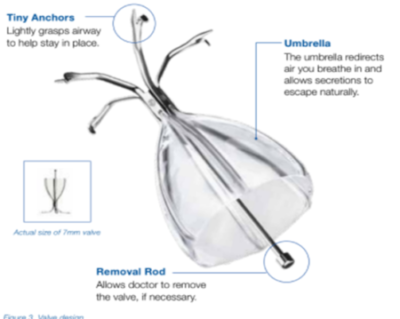Valve Therapy is a minimally invasive procedure, as we introduced it in our March 5 blog. It was Part I of our planned three-part series on Endobronchial Valve Placement. It is also referred to as Spiration Valve Therapy.
This minimally invasive procedure is bringing new hope to emphysema patients, and we are proud to feature it in the FLASS blog. Although this article stands well on its’ own, we regard it as Part II of that our series. (You might want to read or review that Spiration article before continuing with this one.)
Thus, we continue with the story of this typically well-tolerated procedure. We have seen it help emphysema patients find a new love for life.
Spiration Valve Therapy: Points to Ponder–for You and Your Healthcare Team

The Breathlessness of Emphysema Feels Like Being Underwater. Spiration Therapy May Help.
This could be a significant development for More than 15 million Americans who suffer from COPD. You see, as we stated in that previous blog, 3.5 million of those patients have emphysema. That fact means this procedure will highly impact patients who suffer from severe emphysema. Additionally, we emphasize again that this is a procedure is for severe emphysema. It is used when medication and oxygen therapy fail to help. Our patients then face a crossroads where they fear the only recourse is a lung transplant.
At FLASS, we want you to realize that no procedure or surgery is without risks. As we say in our Spiration Valve Therapy brochure, you should address questions concerning risks and concerns with your doctor before the procedure. Likewise, we advise patients to speak to their doctor if they have any discomfort, pain, or any other concerns after your procedure.
Know Your Risks: Before the Doctor implants the Spiration Valve System
Here at FLASS, our doctors and health care professionals believe patients belong on their own healthcare team. We think every member of the healthcare professionals on the team should be fully transparent about the benefits or the risks inherent in any recommended procedure. Likewise, the patient on the team should have a clear understanding of the risks and benefits involved before any procedure.
Know if You are a Candidate for Spiration Valve Therapy

The Valves Placed in Your Lungs Look Like Tiny Umbrellas. The Surgeon Might Place 1 – 4 of These Valves in Your Airway to Help You Breathe.
- Of course, we do not endorse Spiration Valve Therapy if your doctor has diagnosed active asthma, bronchitis, or clinically significant bronchiectasis.
- Let us make this very clear: If you have “swelling of airways (active asthma), inflammation of lung tissue (bronchitis), or airways that have gotten larger and/or infected (bronchiectasis), you should not have Spiration Valves placed in your lungs.”
Other Concerns to Consider With the Spiration Valve Procedure
1. Will I Feel Pain With the Procedure?
We do not want you to have anxiety about the procedure. We want you to understand you will either have sedation or anesthesia as you undergo the placement of the endobronchial valves. Again, anesthesia is an issue you must discuss with your doctor. For any surgical procedure, you need to know about the problems that can occur with sedation or anesthesia.
2. About Your New Valves and MRI
The valves that will properly regulate the amount of air in your lungs will be “MR-conditional.” This means that after receiving your nice, new valves, you can still undergo an MRI procedure. Just the same, we will see that you get a card to give to the MRI specialist if you require an MRI.
3. One More Thing To Double Check: Got Allergies?
Although very unusual, “it is possible that you could have an allergic reaction to the materials used in the Spiration Valve System.” Just be sure you discuss your history of allergic reactions with your doctor.
Valve Therapy: Potential Complications with Bronchoscopy and Valve Placement
No one would ever have surgery if they obsessed too long about the complications that could happen because of a procedure. Thus, we do not want to instill unfounded fear. However, we do want you to understand there are potential complications to bronchoscopy and/or valve placement. Below is a list of the most common ones.
- Pneumothorax (This is an injury to the lung, and it can lead to lung collapse.)
- Anesthesia complications.
- And Bronchial injury.
We also include the possibilities of:
- Chest Pain.
- Lung abscess.
- And Lung Infection.
With Spiration Valve Therapy, some people experience coughing up blood, also known as Hemoptysis.
As you might imagine, under extreme conditions, sometimes a valve might come loose and work its way out of the lung or within the lung.
Valve Therapy: Potential Benefits Hang in the Balance
As we explained in our most recent blog, Spiration Valve Therapy has two great benefits:
- It reduces the volume of diseased parts of the lung.
- And subsequently, the valves can redirect air to the healthier, better functioning parts of the lung.
In the final analysis, these two benefits blend to improve many patient’s overall lung functions. Then, with well-functioning Spiration Valves in place, people with severe or very severe emphysema discover a higher quality of life. They have more energy and more breath to do the things they want to do.
Studies Prove the Efficacy of Spiration Valve Therapy

Spiration Valve Therapy Helps Patients Breathe Easier and Find More Joy in Life.
In a recent clinical trial, the EMPROVE study, with the Spiration Valve System, researchers divided patients into two test groups:
- Doctors treated one group with medication and the Spiration Valve System
- The other group only used medication for their emphysema.
Test Results of this study proved that the group with the Spiration Valve System had better results than the group receiving medication only. Their experiences were heart-warming:
Improvement 1: Better FEV1 Tests showed improved lung function.
Put simply, they showed a 12 % improvement in their FEV1 tests over at 5 months after surgery, and again at 12 months after surgery. And yes, 12 % means a significant, even life-changing improvement for patients with very severe emphysema. Reduction of hyperinflation (air trapped in the diseased portion of the lung): Hyperinflation is a measurement of air trapped in the diseased portion of the lung.
Improvement 2: Reduced Hyperinflation
The treated group showed reduced hyperinflation over six months.
Reducing hyperinflation helps healthier portions of the lung to work more efficiently and allows improvement in overall lung function.
The Big Improvement 3! Dyspnea Decreased!
Dyspnea is the medical term for shortness of breath. It is a major symptom and agonizing problem for patients with severe emphysema. In the test, the treated group demonstrated decreased shortness of breath. With fewer bouts of shortness of breath, these patients felt the impact of improved quality of life.
The researchers measured this improvement in life quality of life with objective questionnaires. The treated group expressed their improvement in their answers to objective questionnaires. Patients were bathing and dressing themselves and walking around their homes. They were enjoying the simple pleasures taken for granted by those blessed without emphysema.
Terrific Take-aways from Our Spiration Truths
When drugs, rehabilitation, and oxygen therapy do not work, FLASS wants you to know, we are offering you a new option to improve your quality of life. We urge you to talk to the healthcare providers of FLASS to see if Spiration Valve Therapy might be right for you.
And thank you for reading our special series of blog articles on this new and promising treatment. Next week, in Part III, we will bring you a step-by-step analysis of the procedure from the patient’s point of view. Plus, you will not want to miss our listing of popular questions and answers. This will include both this specific procedure and severe Emphysema in general.
A Tribute to All Fathers on the Upcoming 2021 Father’s Day, June 21

FLASS Salutes Fathers on Their Special Day! Congratulations!
Certainly, we would be remiss if we did not mention a few words of honor for all the fathers out there in Florida, the USA, the globe, the universe, and beyond!
The National Fatherhood Initiative, states that a highly involved father has a great positive impact on a child’s life. And research shows that more father-child contact within the first 10 years leads to fewer behavioral problems. It can also mean higher marks on reading achievement tests.
Being a mother is tough. There’s no question about it. But make no mistake. Being a father isn’t an easy-breezy walk in the park, either. According to experts at Ask Men, becoming a good dad entails some very impressive skills. They include such things as:
- Firstly, good fathers love being an open-minded disciplinarian who leads by example.
- Dads realize the value of allowing his kids to make their own mistakes–sometimes.
- Good Dads enjoy challenging children.
- They also enjoy spending time with their kids.
- And finally, they personify security by protecting the family.
And last but not least, all the greatest dads know how to demonstrate unconditional love. The healthcare professionals and staff of FLASS send wishes and blessings to all Fathers who will be celebrated this coming week-end. Congratulations!

